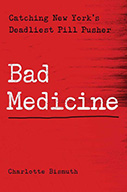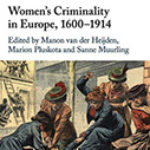Bad Medicine: Catching New York’s Deadliest Pill Pusher

Author: Charlotte Bismuth
Publisher: New York: One Signal Publishers, 2020.
Reviewer: David T. Courtwright | September 2021
“New York’s deadliest pill pusher” was Dr. Stanley “Stan” Xuhui Li. Trained in medicine in China and the United States, Dr. Li worked as an anesthesiologist and pain management specialist at a reputable New Jersey hospital. From 2004 through 2011 he and his wife also ran a not-so-reputable Saturday pain clinic in Flushing, New York. There, after perfunctorily examining cash-paying patients—up to a hundred or more a day, so many they were assigned laminated waiting numbers—Dr. Li wrote 21,837 controlled-substance prescriptions. Most were for oxycodone or Xanax. The enterprise earned more than half a million dollars and, in November 2011, a grand jury indictment with more than 200 counts. In July 2014, after a lengthy trial, the jury found Dr. Li guilty of second-degree manslaughter for the deaths of two patients, Joseph Haeg and Nicholas Rappold; reckless endangerment; and illegal prescription sales. The judge sentenced him to more than ten years in prison.
Charlotte Bismuth, an assistant district attorney who helped investigate and prosecute Dr. Li, tells his story, and hers, in jump-cut fashion. Bad Medicine flashes forward and backward from the trial and crosscuts between two plots, the criminal rise and fall of Stan Li, and the emotional fall and rise of Charlotte Bismuth. The author recounts her personal and professional anxieties, workaholism, depression, divorce, custody battles, childcare problems, and eventual redemption on the way to remarriage and putting Dr. Li behind bars. It is a true-crime story crossed with a stressed-out working-mother story, as told to her analyst.
Though the narrative is cinematic, the contents cannot be faulted for verisimilitude. Bismuth makes her obsessions—overplanning, fixation on details, fear of losing face by making the tiniest error—work for her. No assertion goes unchecked, no courtroom exchange with a witness appears unless from the transcript. Narrative scenes involving witnesses are “reconstructed solely based upon the facts set forth at trial and recorded in the transcript” (xiii). The result is a convincing “prosecutor procedural.”
The mystery is why it took so long to bring down Dr. Li. He operated in plain sight and prescribed, a tipster reported, drugs to young people who didn’t need them. In the mid-twentieth century, local narcotics agents, if not the Federal Bureau of Narcotics itself, would have put a quick end to any such operation. That was why most doctors writing questionable prescriptions for cash operated discretely and limited the frequency of their prescribing. By contrast, Dr. Li ran a volume business, and he ran it openly. He posted a fee schedule that pegged cash payments—$100 for visits of “low complexity,” $150 for “high complexity”—to the number of prescriptions and pills prescribed (250-251). If you wanted more, you paid more. Yet Dr. Li did not come to the attention of the Office of the New York City Special Narcotics Prosecutor until December 2010. And that was only the beginning. Bismuth and her colleagues required more than three years to assemble the scores of witnesses and boxes of documents they judged necessary to convict him.
Amassing evidence was necessary because Dr. Li had some legal cards of his own to play. He had legitimate credentials in pain management, a tenacious defense attorney, and a cover story. That story was that Dr. Li was following accepted medical practice in prescribing potent opioids for long-term management of chronic noncancer pain. The visitors to his Saturday clinic were not addicts. They were pain patients. If they needed more and more opioids and appeared more and more often in his examining room, they were manifesting “pseudoaddiction.” They required upward adjustments of dosage, not to get high, but to keep the pain in check. Dr. Li obliged them.
The trial thus became a battle over two treatment philosophies, an older one that advocated using opioid painkillers sparingly, if at all, in cases of chronic noncancer pain, and the newer, Pharma-backed dispensation of liberalized opioid prescribing that Dr. Li embraced, exploited, and parroted at his trial. Asked if he had learned that chronic opioid use could lead to addiction, he replied, “No, that’s incorrect” (221). Asked if chronic narcotic use could lead to overdose, he replied, flatly, “No” (222). These words came from a physician trained to administer buprenorphine for patients with opioid use disorders. Apparently there were such things as opioid addicts, but not among the run of pain patients at his Saturday clinic, whom he had treated appropriately.
Dr. Alexander Weingarten, testifying as a defense expert, doubled down on the pseudoaddiction theory. He claimed the doses Dr. Li prescribed were not risky because they were accepted “in the pain management community.” The real question, Bismuth observes, was whose pain management community? Her answer is the one created by opioid manufacturers and their front organizations and paid medical opinion leaders. Among these was the accommodating Dr. Weingarten, who collected $132,000 from twenty-three pharmaceutical companies the year he testified on behalf of Dr. Li. As it happened, Dr. Weingarten was also a star speaker for Insys, several of whose executives were subsequently convicted of bribing doctors to prescribe Subsys, a fentanyl analgesic.
The prosecution countered Dr. Weingarten with its own expert, Dr. Christopher Gharibo. Real pain medicine, Dr. Gharibo said, was a complex and interdisciplinary field. Pain patients need to be assessed individually and treated in multimodal fashion, not just with opioid analgesics prescribed in quick response to an initial complaint. “This is not pain management,” he said of Dr. Li’s assembly-line practice (214). Pressed to say what it was, Dr. Gharibo blurted out, “He’s doing it to feed an addiction network as part of his business model” (215).
Given that Dr. Li also engaged in insurance fraud; ignored pleas from patients’ relatives to quit writing prescriptions; altered incriminating medical records; and lost sixteen patients, Haeg and Rappold among them, to opioid-related overdoses, the jury had little trouble embracing the prosecution’s greed theory. Bismuth’s aim is to situate this particular tragedy of greed, into which she was drawn as an assistant prosecutor, within the larger corporate tragedy of greed that triggered the national prescription opioid addiction epidemic, raging as Dr. Li presided over his clinic. Bad Medicine opens, not with a vignette of the defendant’s reckless behavior, but with a Purdue Pharma brochure reassuring OxyContin patients that the drug’s effect in a medical context was “beneficial, not harmful,” and that addiction fears should “not stand in the way of relief from pain” (1).
Regular prescriptions of large doses of potent prescription opioids could in fact lead to addiction and overdoses, either directly or indirectly through diversion. Few of Dr. Li’s patients were opioid-naïve subjects when they first visited his clinic. Dr. Li himself said, at his sentencing hearing, that many already had “both problems of severe pain and [a] high level of opioid tolerance” (318-319). Yet he was performing more than a maintenance service, as many of his patients also shared, bartered, or sold a portion of the drugs obtained from his prescriptions—a point Bismuth emphasizes. Dr. Li must have known of the diversion, as his fee schedule carried a surcharge for early return visits. If you want to sell more, you have to pay more. Meanwhile let’s all pretend we’re involved in legitimate pain management, as authorized by the new prescribing regime.
Bismuth makes it clear that Dr. Li reaped a harvest planted by others. She does not, however, make clear his character and motives. He was greedy, certainly. Yet greedy pill-mill doctors are often marginal practitioners, or they are caught up in an expensive divorce or some other financial crisis. Dr. Li, who was well trained, board certified, and employed at a good hospital, was none of these things. And his callous disregard of his patients’ wellbeing was unusual, even by pill-mill standards. Possibly he was a sociopath. Possibly he rationalized that his patients were confirmed addicts who were going to score anyway, professional scruples or no. Possibly his cynicism and insensitivity were rooted in his youthful experience of the Cultural Revolution, a tantalizing biographical clue Bismuth’s introduces late in the narrative, but which she fails to pursue.
In the end, her Dr. Li remains as unfathomable as Iago — whose fate Dr. Li shared. In April 2020, Dr. Li succumbed to Covid-19 while serving his sentence at the Fishkill Correctional Facility — news that broke too late for inclusion in the book. Bismuth issued a post-publication statement that summarized the affair: “Dr. Li betrayed his patients, his medical oath and society when he sold prescriptions for cash. Two young men lost their lives because of his greed. But Dr. Li was sentenced to prison–not death. COVID short-circuited justice and I would never wish a lonely, painful death on anyone.”
David T. Courtwright is Presidential Professor Emeritus, University of North Florida.


